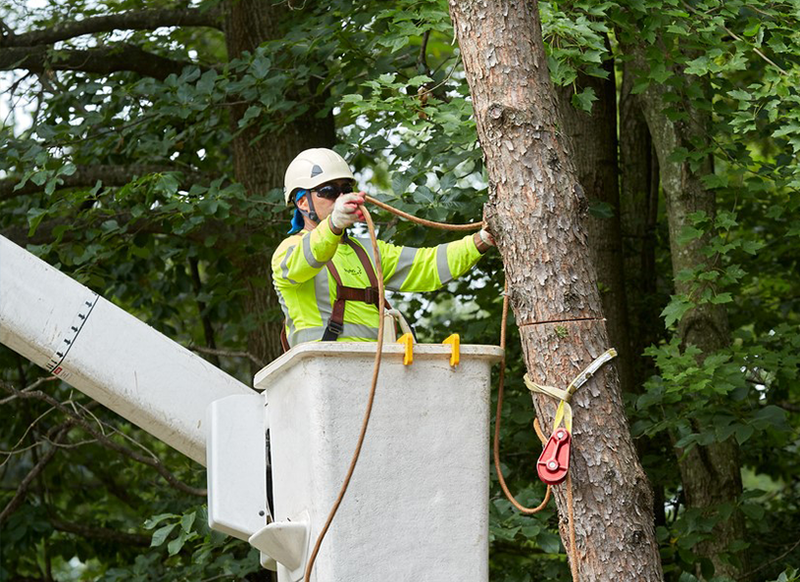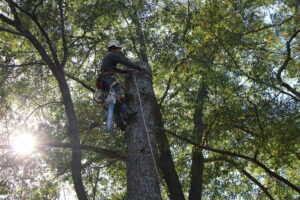If you are faced with the task of removing a palm tree from your property, do not despair! Remove a palm tree may seem to be a difficult process, but with the appropriate direction and some elbow grease, it can be a do-it-yourself effort. We will lead you through the stages, give recommendations, and share some personal stories to make the process exciting and simple to grasp.
Analyzing the Situation For Removal of Palm Tree
Before you begin the process of removing a palm tree, you must first examine the issue. The kind of palm tree, its size, and its location all have an impact on the method you should adopt.
Identify the Palm Tree Species: Start by determining the kind of palm tree you have. Different species have unique properties that might influence the removal procedure. Some palms have thin trunks, whilst others have massive trunks. Understanding the individual species will assist you in making appropriate plans.
Examine the Palm Tree’s Size: The size of the palm tree is important, particularly when it comes to removal. Smaller palm trees may need less labor and equipment, whilst bigger ones may be more difficult. To gain a good idea of what you’re working with, measure the tree’s height and the diameter of its trunk.
Consider the Setting: The position of the tree is critical. Is it close to your home, electricity lines, or other structures? Is it near other plants or trees that you wish to protect? The placement of the tree will help you identify the safest approach to remove it.
First and foremost, safety.
When removing a palm tree, safety should always come first. Take the essential steps to keep yourself and others safe throughout the procedure.
Gather Safety Equipment: Before you begin, make sure you have all of the necessary safety equipment. Gloves, safety goggles, a hard helmet, hearing protection, and work boots with high grip are also required. Never jeopardize your safety.
Check for Utility Lines: Any underground utility lines around the palm tree must be located. To designate the lines, contact your local utility provider. This step is critical in order to prevent accidents or service interruptions.
Plan Your Escape Route: Always have an escape route in mind in case of an emergency. Make sure you can get away from the tree swiftly if necessary.
Tools and Equipment
Now that you’ve evaluated the issue and assured your safety, it’s time to assemble the palm tree removal tools and equipment.
- A chainsaw is an essential instrument for palm tree removal. Check that it is in excellent operating order and has a sharp chain.
- A ladder may be required to reach the highest areas of the palm tree, depending on its height. Select a strong ladder that can withstand your weight.
- Pruning Shears or a pruning saw will be useful for trimming branches and fronds.
- Ropes and pulleys are required for safe tree removal. They assist you in directing the tree’s fall in the appropriate direction.
- Use a protective tarp or plastic sheets below the tree to protect your surroundings from falling debris.
- If you want to remove the stump of the palm tree, a stump grinder will make the task much simpler.
How to Remove a Palm Tree?
You’re ready to start removing a palm tree now that you’ve gathered your safety equipment and tools. Here are the actions to take:
Step 1: Trim the Fronds: Begin by pruning the palm tree’s fronds or leaves. For this, use pruning shears or a pruning saw. When operating at a height, use extreme caution.
Step 2: Remove the Nuts: If the palm tree produces nuts or seeds, remove them. This hinders the growth of additional palm trees in the future.
Step 3: Cut the Trunk: Make a horizontal cut as close to the ground as possible using the chainsaw. This is called the undercut, and it dictates which way the tree will fall.
Step 4: Make the Back Cut: On the opposite side of the undercut, make a second, slightly higher, horizontal cut. This cut should connect with the undercut to form a notch. This is known as the back cut.
Step 5: Insert Wedges: To guarantee the tree falls in the right direction, insert wedges into the back cut. If required, use ropes and pulleys to guide the fall.
Step 6: Felling the Tree: Carefully and gradually cut through the remaining uncut wood between the undercut and the back cut with the chainsaw. The tree should begin to fall in the intended direction.
Step 7: Remove the Stump: A stump grinder may be used to remove the palm tree’s stump. This machine grinds the stump into wood chips, making disposal simpler.
Palm Tree Removal and Disposal
You must cope with the debris now that the palm tree has fallen. Proper disposal is critical for maintaining a clean and safe environment.
Cutting and Bundling: Cut the trunk and branches of the palm tree into manageable portions. Combine them for simpler shipping.
Green trash Recycling: Many towns have programs in place to recycle green trash. Check to see whether your municipality provides similar services. It is an environmentally beneficial method of removing palm tree detritus.
Hire a Debris Removal Service: If you have a large quantity of palm tree debris, you might think about hiring a debris removal service. They have the necessary equipment and skills to manage heavy weights.
Problems with Palm Tree Removal
While removing a palm tree is a do-it-yourself process, there are some obstacles to be aware of. Let’s look at some of these obstacles and how to overcome them.
- Removing the palm tree securely might be difficult if it is near buildings, electrical wires, or other impediments. To prevent mishaps in such instances, it is important to seek expert assistance.
- Palm plants can have enormous root systems. Removing the stump and roots may be time-consuming. A stump grinder may make this job easier.
- If you’ve never removed a palm tree before, your lack of experience might lead to safety hazards and blunders. For your first try, always consider getting advice or expert support.
- Removing a palm tree may need permission in certain locations, particularly if it is a protected species. Check with your local authorities to make sure you’re in line with the rules.
FAQs
Is it feasible for me to remove a palm tree on my own?
It is feasible to remove a palm tree on your own, but it is a difficult process that requires the proper tools, safety measures, and some skill. If you are unclear about the procedure or if the tree presents a safety issue, it is best to get expert help.
Is a permission required to remove a palm tree?
In certain locations, removing a palm tree may need permission, particularly if it is a protected species. Check with your local authorities or an arborist to see whether a permit is necessary in your unique site.
How do I properly dispose of palm tree debris?
To properly dispose of palm tree trash, cut the trunk and branches into manageable portions. Combine them for simpler shipping. If available, use green trash recycling programs provided by your municipal garbage management. You may engage a debris removal service for heavier loads.
What measures should I take before removing a palm tree?
When removing a palm tree, safety comes first. Make sure you have the proper safety equipment, such as gloves, safety goggles, a hard helmet, hearing protection, and traction work boots. Check for utility wires, prepare an escape route, and observe all safety precautions.
How can I tell what kind of palm tree I have?
You may determine the species of your palm tree by looking at its fronds, the appearance of the trunk, and the sort of fruit or nuts it produces. There are also internet tools and applications that may assist you in identifying various palm tree species.
Conclusion
Removing a palm tree may be a difficult but rewarding do-it-yourself effort. You may effectively remove a palm tree from your property if you have the correct tools, equipment, safety precautions, and a step-by-step strategy. However, if you are unsure about the procedure or if the tree presents a safety danger, you should always seek expert help.
We’ve covered the necessary stages, safety considerations, equipment, and disposal techniques in this guide to assist you manage the palm tree removal process.
Remember to analyze the situation, prioritize safety, and dispose of the material safely. Your palm tree removal trip may be as successful and enjoyable as it was for Maria and Tom. Happy palm tree removal, and may your home be changed into a more secure and appealing environment!




